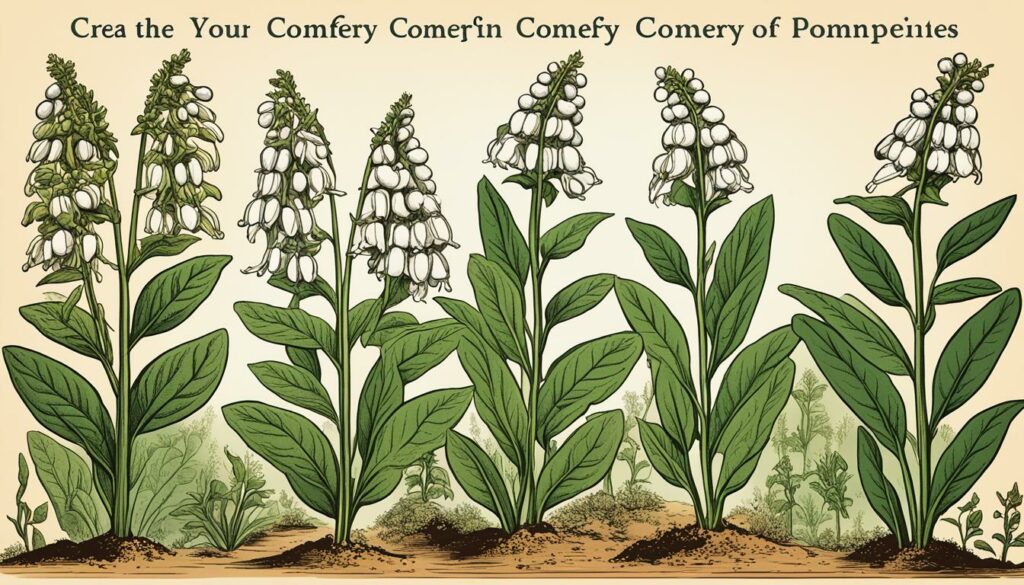Welcome to our guide on harnessing the healing powers of comfrey. In this article, we will explore the various uses of comfrey, its medicinal benefits, and how you can incorporate this incredible herb into your wellness routine. Whether you are seeking pain relief, improved bone health, or solutions for skin conditions, comfrey can be a natural and effective option. Let’s dive in!
What is Comfrey?
Comfrey is a plant with potent healing properties that have been recognized for centuries. Also known as Symphytum officinale, comfrey is particularly prized for its high concentration of allantoin, a compound that promotes the growth of new cells in the body.
This herbaceous plant, found in both the roots and leaves of comfrey, possesses remarkable characteristics that make it a valuable asset in natural healing. Allantoin, as a cell proliferant, plays a vital role in stimulating the growth of new cells, which accelerates the healing process for various ailments.
Comfrey is highly regarded for its ability to alleviate pain, improve bone health, and treat skin conditions. It exhibits potent anti-inflammatory properties and is commonly used to heal wounds, burns, and broken bones.
Here is an insightful quote from a renowned herbalist:
“Comfrey is a remarkable plant that has been revered for centuries for its healing properties. With its abundance of allantoin, comfrey has the ability to promote the growth of new cells, making it a valuable ally in the quest for wellness.” – Herbalist Jane Robertson
The power of allantoin in comfrey cannot be understated. This unique compound, coupled with the plant’s anti-inflammatory abilities, makes comfrey a versatile and effective natural remedy.
To give you a better understanding of the characteristics of comfrey, let’s explore the different applications and benefits of this remarkable herb.

Key Characteristics of Comfrey:
- Rich in allantoin, a cell proliferant that stimulates the growth of new cells
- Displays potent anti-inflammatory properties
- Used for healing wounds, burns, and broken bones
- Recognized for its pain-relieving abilities
- Effective in treating various skin conditions
The History of Comfrey and Allantoin
Comfrey has a rich history dating back to the 16th century, where it was widely used for its remarkable healing properties. Even before scientists identified allantoin as the active compound in comfrey, healers and doctors recognized its effectiveness in promoting cell growth and healing wounds.
Allantoin, found abundantly in comfrey, has since been studied and revealed to have significant healing abilities. Comfrey’s other components, including proteins, vitamin B12, and its mucilaginous quality, work synergistically with allantoin to enhance its healing action.
Through generations, comfrey has stood the test of time as a trusted natural remedy, valued for its remarkable ability to promote tissue regeneration and accelerate the body’s healing processes.

The Healing Properties of Comfrey
Comfrey’s healing properties are attributed to its unique combination of bioactive compounds, particularly allantoin. Allantoin stimulates cell proliferation, allowing for the growth of new tissue and aiding in the healing process.
Comfrey’s mucilaginous quality provides a protective barrier over wounds, preventing infection and promoting faster healing. Additionally, the herb’s proteins and vitamin B12 content contribute to its restorative properties, nourishing the body at a cellular level.
“The healing powers of comfrey are truly remarkable. Its ability to promote tissue regeneration and accelerate wound healing is unmatched by many other natural remedies.” – Dr. Emily Thompson, Herbalist
Ancient Wisdom Meets Modern Science
The use of comfrey for healing dates back centuries and is deeply rooted in traditional medicine practices. Today, as scientific research continues to uncover the benefits of natural remedies, comfrey’s healing potential is gaining recognition in mainstream healthcare.
Studies have shown comfrey’s efficacy in treating various conditions, including inflammation, bone fractures, eczema, and dermatitis. Its ability to alleviate pain, promote skin rejuvenation, and support bone health has made it a valuable addition to holistic wellness practices.
Ancient Wisdom Meets Modern Science
| Healing Properties of Comfrey | Treatment | Benefits |
|---|---|---|
| Pain Relief | Arthritis, muscle soreness, back pain | Reduces discomfort, improves mobility |
| Bone Health | Fractures, osteoporosis | Accelerates bone healing, strengthens bone density |
| Skin Conditions | Eczema, dermatitis, psoriasis | Soothes inflammation, promotes skin rejuvenation |
The therapeutic potential of comfrey continues to be explored, making it an exciting topic of interest for researchers and individuals seeking natural alternatives to support their well-being.
The Root of Comfrey
Comfrey is a versatile herb that can be easily grown from root cuttings. Whether you prefer indoor or outdoor gardening, comfrey thrives in various conditions, making it a suitable addition to any garden.
Harvesting comfrey roots is best done during the dormant winter months when the concentrations of allantoin, the healing compound in comfrey, are at their highest. To extract the roots, gently dig around the plant and carefully lift the clump of roots from the ground.
Once harvested, the comfrey roots should be cleaned and prepared for future use. Start by peeling the outer layer of the roots to reveal the inner goodness. Then, chop the roots into small pieces, creating manageable portions for drying. Drying the roots ensures their longevity and convenient storage.
Proper preparation of comfrey root is essential for maximizing its potency. When steeping comfrey root, it is advisable to use distilled or soft water to avoid any impurities that may impact its healing properties. Bring the water to a gentle boil and steep the chopped roots just below the boiling point. This will allow the extraction of the beneficial compounds while retaining their efficacy.
Comfrey root can be transformed into a powder or further chopped for easy brewing. Whichever form you choose, the root holds the same powerful healing properties that comfrey is known for. Now that you have prepared comfrey root, you can start exploring its numerous therapeutic applications.

Uses for Comfrey
Comfrey, with its unique healing properties, offers a variety of uses for promoting wellness. Whether you’re seeking relief from pain, healing for bone fractures, or treatment for skin conditions, comfrey can be a natural solution.
1. Comfrey for Pain Relief
Comfrey has been traditionally used to alleviate pain and discomfort associated with conditions such as arthritis, muscle soreness, and back pain. Its anti-inflammatory properties help reduce swelling and inflammation, providing soothing relief.
2. Comfrey for Bone Fractures
When it comes to healing broken bones, comfrey can be remarkably effective. The high concentration of allantoin in comfrey stimulates the growth of new cells, promoting faster bone healing and strengthening. Adding comfrey to your healing regimen may speed up the recovery process.
3. Comfrey for Skin Conditions
Comfrey is renowned for its benefits in treating various skin conditions, including eczema, psoriasis, and dermatitis. Its anti-inflammatory and cell-regenerative properties help soothe irritated skin, reduce redness, and promote overall skin health.
By harnessing the healing power of comfrey, you can experience relief from pain, enhanced bone healing, and healthier skin. It is important to note that while comfrey offers numerous benefits, it is essential to use it responsibly and consult with a healthcare professional before incorporating it into your wellness routine.

How to Use Comfrey
Comfrey offers a range of applications that align with your wellness goals. Whether you prefer topical treatments or internal consumption, there are various ways to harness the healing power of this medicinal herb.
Using Comfrey Leaves
Fresh or dried comfrey leaves can be used topically to address specific concerns or incorporated into homemade creams and ointments for a convenient, targeted approach. For topical use:
- Create a poultice: Crush fresh comfrey leaves and apply directly to the affected area to promote healing and reduce inflammation. Cover with a clean cloth or bandage and leave for several hours or overnight for optimal results.
- Infuse into oils: Dry comfrey leaves can be steeped in carrier oils such as olive, coconut, or almond oil to create a soothing and medicinal oil blend. Use the infused oil to massage onto the skin or add to your bath for a relaxing soak.
Making Comfrey Cream
If you prefer a more readily accessible form, you can make comfrey cream at home. Comfrey cream is ideal for addressing skin conditions and providing localized relief for pain and inflammation. Here’s a simple recipe to get you started:
DIY Comfrey Cream Recipe:
- Melt 1/2 cup of coconut oil in a double boiler.
- Add 1/4 cup dried comfrey leaves and gently heat for 1-2 hours, stirring occasionally.
- Strain the mixture through a fine mesh strainer or cheesecloth to remove the leaves.
- Add 1 tablespoon of beeswax to the strained oil and continue heating until fully melted.
- Remove from heat and let the mixture cool before transferring to a sterilized jar.
- Store in a cool, dark place and apply as needed.
Other Comfrey Preparations
If you prefer internal consumption for systemic healing, comfrey can be used in the form of tea or capsules:
- Comfrey tea: Steep 1-2 teaspoons of dried comfrey leaves in hot water for 10-15 minutes. Strain and enjoy as a herbal tea. To enhance the flavor, you can add honey or lemon.
- Comfrey capsules: You can find comfrey capsules in health food stores or online. Follow the recommended dosage instructions provided by the manufacturer.
Regardless of the form of preparation, it’s important to ensure the maximum potency of the herb. Use distilled or soft water for brewing, and follow the specified steeping times and temperatures.

Comfrey is a versatile herb that can be used in different ways to address your specific wellness needs. Whether you choose to use comfrey leaves topically, create homemade comfrey cream, or consume it internally, this powerful herb has the potential to promote healing and support your overall well-being.
Skin and Health Benefits of Comfrey
Comfrey offers numerous benefits for both your skin and overall health. This powerful herb has been used for centuries to promote healing and provide relief from various conditions. Let’s explore how comfrey can improve your skin health and alleviate common ailments.
Improves Skin Health
Comfrey is known for its soothing and healing properties, making it a popular ingredient in skincare products. The herb helps reduce inflammation, calm irritated skin, and accelerate the healing process. By promoting skin rejuvenation, comfrey can effectively treat conditions like cracked nipples and pressure ulcers.
Relieves Back Pain
If you suffer from upper or lower back pain, comfrey may offer you much-needed relief. The herb’s analgesic and anti-inflammatory properties can alleviate discomfort and reduce inflammation in the affected area. Whether it’s due to muscle strain or chronic conditions like osteoarthritis, comfrey may help improve your quality of life.
Reduces Ankle Sprain Symptoms
Ankle sprains can be painful and limit your mobility. Comfrey, with its anti-inflammatory and healing properties, can help reduce swelling and promote the healing process. Applying comfrey topically or using comfrey cream may hasten recovery and get you back on your feet faster.
Improves Osteoarthritis Symptoms
Osteoarthritis is a degenerative joint condition that can cause pain and decreased mobility. Comfrey has shown promising results in improving knee mobility and reducing pain associated with osteoarthritis. Whether used topically or consumed as a tea, comfrey may be a natural option to enhance your joint health and overall well-being.
To fully understand the benefits of comfrey, it’s important to consult with a healthcare professional before incorporating it into your wellness routine. They can provide guidance on proper usage and dosage to ensure your safety and maximize the potential benefits.

| Skin and Health Benefits of Comfrey | |
|---|---|
| Benefit | Description |
| Improved Skin Health | Comfrey soothes and heals inflammation, promotes skin rejuvenation, and treats conditions like cracked nipples and pressure ulcers. |
| Relief from Back Pain | Comfrey’s analgesic and anti-inflammatory properties help reduce back pain, providing much-needed relief for sufferers. |
| Reduced Ankle Sprain Symptoms | Applying comfrey topically or using comfrey cream can help reduce swelling and promote healing for ankle sprains. |
| Improved Osteoarthritis Symptoms | Comfrey has shown promise in improving knee mobility and reducing pain associated with osteoarthritis. |
Possible Side Effects of Comfrey
While comfrey has many medicinal benefits, it is essential to be aware of its potential side effects. Comfrey contains pyrrolizidine alkaloids, which can be toxic to the liver and may increase the risk of liver damage and cancer.
Oral consumption of comfrey is strongly discouraged, and even topical use should be done with caution. It is important to consult with a healthcare professional before using comfrey and follow proper dosage guidelines.
The Toxicity of Comfrey
Comfrey contains pyrrolizidine alkaloids, which are natural compounds that can be toxic to the liver when consumed in large amounts or over an extended period. These alkaloids can cause liver damage and may even increase the risk of developing liver cancer. While comfrey is generally safe for external use in small amounts, it is crucial to exercise caution.
Topical applications of comfrey should be limited to small areas of the skin and used in accordance with professional guidance. Avoid using comfrey on open wounds, broken skin, or mucous membranes to prevent potential absorption into the bloodstream.
Comfrey Side Effects
Although comfrey has many potential benefits, its side effects should not be overlooked. Some common side effects of comfrey include:
- Abdominal pain
- Nausea
- Vomiting
- Diarrhea
These side effects may occur after oral consumption of comfrey or excessive topical application. If you experience any of these symptoms, it is recommended to discontinue use and seek medical advice.
Remember that consulting with a healthcare professional before using comfrey is crucial, especially if you have underlying health conditions, are pregnant or breastfeeding, or are considering long-term use.
Dangers of Comfrey
Due to the potential toxicity of comfrey, it is important to be aware of the dangers associated with its use. Long-term or excessive consumption of comfrey, especially in the form of tea or dietary supplements, can pose serious health risks. Ingesting comfrey products that contain pyrrolizidine alkaloids may lead to:
- Liver damage
- Liver failure
- Liver cancer
It is crucial to exercise caution and prioritize your health when considering the use of comfrey. Always follow recommended guidelines and consult with a healthcare professional to determine the appropriate use and dosage for your specific needs.
Comfrey Dosage and Safety Precautions
When it comes to using comfrey, it’s important to understand the proper dosage and take necessary precautions to ensure your safety. Here are some guidelines to follow:
Comfrey Dosage
The dosage of comfrey varies depending on the form of use. For topical applications, such as using comfrey-infused oils or creams, apply a thin layer to the affected area up to three times a day. When creating comfrey poultices, make sure to cover the affected area with a cloth soaked in a comfrey solution.
If you prefer internal consumption, it is crucial to note that oral use of comfrey is considered highly unsafe due to its potential toxicity. Therefore, it is strongly advised to avoid consuming comfrey orally.
Safety Precautions when Using Comfrey
- Topical use of comfrey should be limited to the recommended dosage and duration. Avoid applying comfrey on open wounds or mucous membranes, as it can lead to unwanted side effects.
- Before using comfrey, it’s essential to consult with a healthcare professional, especially if you have any underlying health conditions or are taking medications. They can provide personalized guidance and ensure comfrey is safe for you to use.
- If you experience any adverse reactions, such as skin irritation, allergic reactions, or discomfort, discontinue use immediately and seek medical advice.
By following these dosage guidelines and safety precautions, you can safely enjoy the benefits of comfrey while minimizing the potential risks. Remember, your health and well-being are of utmost importance.

Continue reading to learn about the various benefits of comfrey, including its effectiveness in relieving pain, promoting bone health, and improving skin conditions.
Conclusion
Comfrey, with its high concentration of allantoin, has a long history of medicinal use and offers many benefits for natural healing. However, it is important to exercise caution due to its potential side effects. Consulting with a healthcare professional before incorporating comfrey into your wellness routine is advised. When used correctly and in moderation, comfrey can be a valuable remedy for pain relief, bone health, and various skin conditions.
The Benefits of Comfrey
- Pain relief: Comfrey can help alleviate arthritis, muscle soreness, and back pain.
- Bone health: It stimulates cell growth, promoting bone healing and preventing fractures.
- Skin conditions: Comfrey aids in soothing and healing skin conditions like eczema and dermatitis.
Comfrey, when used correctly and in moderation, can be a powerful natural remedy for pain relief, bone health, and skin conditions.
Remember, moderation is key when using comfrey. It is always best to consult with a healthcare professional to ensure its safe and effective use. Embrace the natural healing properties of comfrey and discover its potential to support your overall wellness.

Additional Keywords Distribution
Throughout this article, we have covered various aspects of comfrey, exploring its medicinal benefits and uses for healing. Comfrey has been used for centuries to promote wellness and treat a range of conditions, and its effectiveness cannot be denied. Let’s take a closer look at how comfrey can be beneficial for healing, bruises, sprains, and skin conditions, as well as the role of comfrey cream in enhancing its healing properties.
When it comes to healing, comfrey has been revered for its ability to stimulate cell growth and promote faster recovery. Whether you have a bone fracture, a sprained ankle, or any other injury, comfrey can help speed up the healing process. Its potent compounds, including allantoin, work synergistically to reduce inflammation and support tissue repair. Applying comfrey cream topically can provide localized relief and aid in the healing of bruises, sprains, and other minor injuries.
Comfrey is also known for its effectiveness in addressing various skin conditions. From eczema and psoriasis to dermatitis and minor wounds, comfrey’s anti-inflammatory and cell regenerating properties can provide relief and assist in the healing process. Using comfrey cream on affected areas can help soothe irritation, reduce redness, and promote the rejuvenation of healthy skin cells.
However, it’s important to note that while comfrey is a natural remedy with powerful healing properties, it should always be used with caution. Since comfrey contains certain compounds that may be toxic when consumed orally, it’s best to stick to topical applications such as comfrey cream. Consultation with a healthcare professional is recommended, especially if you have any pre-existing medical conditions or are taking medications.
FAQ
What are the medicinal benefits of comfrey?
Comfrey has numerous medicinal benefits, including pain relief, bone healing, and treatment of skin conditions.
How can I use comfrey for healing?
Comfrey can be used topically as a poultice, infused into oils for creams and ointments, consumed as a tea, or taken in capsule form for internal healing.
What is comfrey used for?
Comfrey is commonly used for pain relief, bone fractures, sprains, and treating skin conditions like eczema and dermatitis.
How do I use comfrey leaves?
Comfrey leaves can be used topically as a poultice or infused into oils for creams and ointments.
How can I make comfrey cream?
Comfrey cream can be made by infusing comfrey leaves in oil and combining it with other ingredients like beeswax and essential oils.
What are the skin and health benefits of comfrey?
Comfrey can improve skin health, relieve back pain, reduce symptoms of sprains, and improve knee mobility in osteoarthritis patients.
What are the possible side effects of comfrey?
Comfrey contains pyrrolizidine alkaloids, which can be toxic to the liver and may increase the risk of liver damage and cancer.
What is the recommended dosage of comfrey?
The dosage of comfrey varies depending on the form of use, but it is crucial to follow recommended guidelines and not exceed the recommended dosage.
Is comfrey safe to use?
While comfrey has many medicinal benefits, it is essential to be aware of its potential side effects. Oral consumption of comfrey is strongly discouraged, and even topical use should be done with caution.
What are some other uses for comfrey?
Comfrey can also be used for healing bruises, sprains, and various skin conditions. Comfrey cream is a popular option for topical application.
Source Links
- https://thegoodstuffbotanicals.com/comfrey-leaf-benefits-for-skin/
- https://www.stylecraze.com/articles/comfrey-benefits/
- https://shopify.motherearthliving.com/health-and-wellness/what-is-comfrey-ze0z1401zbla/

